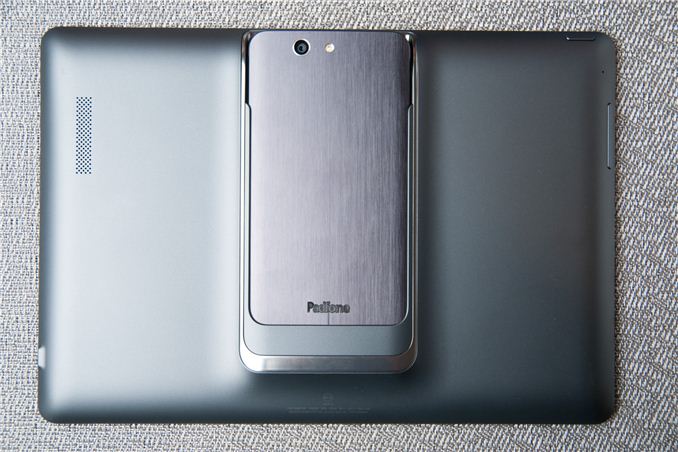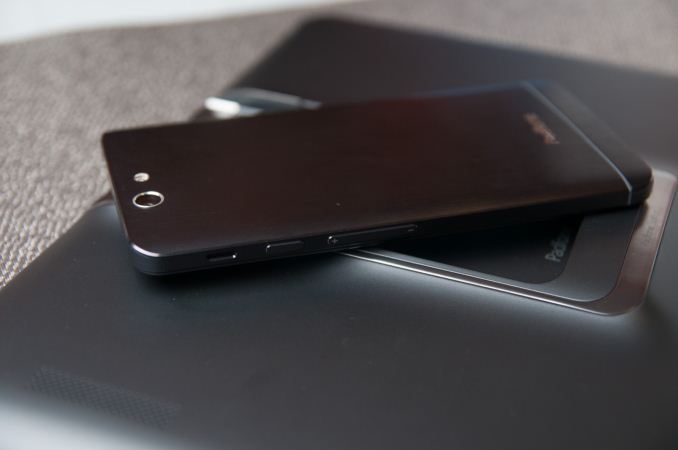Hands on with the new ASUS Padfone Infinity
by Brian Klug on September 17, 2013 9:00 AM EST- Posted in
- Smartphones
- Asus
- Mobile
- Padfone
- Tablets
- Android 4.2
- Snapdragon 800

For a while now, ASUS has been pushing form factor boundaries in the mobile space, with dockables and other 2-in-one platforms that once seemed radical but really started making sense after a while. I've been itching to get to try one such category for a while now, the Padfone, which combines 10.1-inch tablet form factor display and battery with a 5-inch form factor smartphone device. Compute resides in the smartphone form factor device, but when docked into the Padfone station, you bring everything over with you including connectivity, media, and the platform itself. ASUS has been selling the Padfone line for a while now, and we just recently received the new Padfone Infinity based on Snapdragon 800 to play around with.
The Padfone Infinity is based on a Snapdragon 800 platform with the 2.2 GHz Krait 400 clocks inside, and 450 MHz Adreno 330 GPU. There's also 2 GB of LPDDR3 alongside. I'll save the rest of the spec listing for the table, but the Padfone Infinity is absolutely bleeding edge in terms of both its camera, displays on both the smartphone and station, and SoC inside. I've only been playing with the Padfone for a short time, but UI is very smooth in both modes, and the transition between tablet and phone operation is very fast.
| ASUS Padfone Infinity | |
| SoC |
Qualcomm Snapdragon 800 (MSM8974) 4x Krait 400 2.2 GHz, Adreno 330 GPU |
| Display |
5-inch 1080p IPS (PadFone) 10.1-ich 1920x1200 IPS (PadFone Station) |
| RAM | 2 GB LPDDR3 RAM |
| WiFi | 802.11a/b/g/n/ac + BT 4.0 |
| Storage |
16/32 GB Internal, microSD slot (up to 64 GB), 50 GB ASUS WebStorage |
| I/O |
3.5mm headphone, nanoSIM, myDP (USB 2.0 host+device, 1080p video out) |
| OS | Android 4.2.2 |
| Battery |
2400 mAh (PadFone) 5000 mAh (PadFone Station) |
| Size / Mass |
143.5 x 72.8 x 8.9mm, 145 grams (PadFone) 264.6 x 181.6 x 10.6mm, 532 grams (PadFone station) |
| Camera |
2 MP w/AF, F/2.0 (Front) 13 MP w/AF,LED F/2.0 (Rear) |
| Network |
EDGE/GPRS/GSM: 850/900/1800/1900MHz
UMTS/DC-HSPA+: 850/900/1900/2100MHz
(DL: 42Mbit/s / UL: 5.76Mbit/s)
LTE Cat 4: 800/1800/2600MHz
(DL: 150Mbit/s, UL: 50Mbit/s) |
I've been wanting to take a look at the Padfone line for a long time regardless of the fact that there's no variant yet with USA-appropriate LTE bands. The other side of the Padfone is that US operators seem to be hostile to the form factor for some reason, of course it's an obvious way for consumers to get both tablet and smartphone under a single data plan.
I've been impressed with ASUS hardware build quality since playing with some of the earliest mobile devices, and it has continued to improve. The Padfone Infinity seems to have nailed the insert/eject force for the smartphone module, and the docking station tablet seems to be pretty solid. The industrial design is almost the same as the Padfone Infinity I played with at MWC earlier this year, though the new Padfone infinity adds a diamond cut edge to the rear of the phone to make it less sharp when held in the hand. I was impressed then with the use of metal on the smartphone module and continue to be impressed with both build quality and way that handset feels. I'm buried in smartphones and devices for this refresh period before the holidays, but we're definitely going to take a longer look at the Padfone Infinity.

















34 Comments
View All Comments
En1gma - Tuesday, September 17, 2013 - link
again its asus's NEW proprietary connector???Flunk - Tuesday, September 17, 2013 - link
Yes ever ASUS connector is totally unique, like a fingerprint.djc208 - Tuesday, September 17, 2013 - link
There are quite a few benefits. There are no syncing issues across two devices since it's just one device (your phone) that can drive a larger display. The tablet portion should be cheaper as it's mostly display and battery. Plus all your connectivity is tied to the phone, so you don't have to share a data plan, or have tethering enabled to use the tablet off of wifi, all that is provided by the phone you already use. Considering most high end smart phones are using essentially the same SOC as many tablets it makes sense that you could buy the hardware once and use it in two form factors.Another big benefit would be that at home most people with both phone and tablet rely on the tablet, so texts and calls can be missed if you are not near the phone, in this case that would not be an issue as they are the same device.
sherlockwing - Tuesday, September 17, 2013 - link
The problem with this design is that your SOC have the thermal limits of a phone SOC instead of a Tablet SOC. Just look at the Nexus 7 review and you will see that Nexus 7(1.5Ghz Krait 300) out performs GS4 (1.9Ghz Krait 300 )because it stays at its max clock much longer while the GS4 SOC oscillates between 1.9Ghz and 900 mhz.boeush - Tuesday, September 17, 2013 - link
I dunno, I wouldn't write it off just yet (until the performance is actually tested.) In docked mode, the phone can switch off its screen, and it can mooch off the tablet's battery -- which would save on heat generated internally inside the phone. Also, just being in contact with the tablet helps because it cools the phone faster than only being in contact with air (or with a hand holding the phone); the phone/tablet having metal surfaces would further facilitate the heat transfer (so the tablet would tend to act as a rather large heat sink.) Seems like, with some clever engineering, this could be made to perform quite well.I'm intrigued; awaiting a full review and wondering if this would ever come to Verizon (alleged hostility by carriers being rather disconcerting news...) Also wondering as to the quality of the camera on the phone -- and whether it has good OIS: not listed in the spec sheet, but something I'd think an absolute requirement these days for anything to be considered "absolutely bleeding edge in terms of ... its camera".
snoozemode - Tuesday, September 17, 2013 - link
Unfortunately the price has always been very high for the padone+dock and never really made sense from a price point of view.CrystalBay - Tuesday, September 17, 2013 - link
Very Nice...Travis Jackson - Tuesday, September 17, 2013 - link
Even if six months or a year away, I would love to see a Bay Trail version of this!boeush - Tuesday, September 17, 2013 - link
A year away, I'd expect a Merrifield version. That's when it really starts to get awesome...*wipes drool off chin*
boeush - Tuesday, September 17, 2013 - link
And actually, a full year from now I'd expect Airmont-based refresh of something like Merrifield. 14nm chips in a phone...*starry eyes*